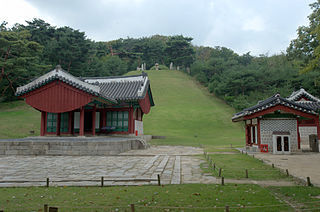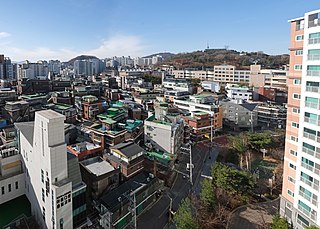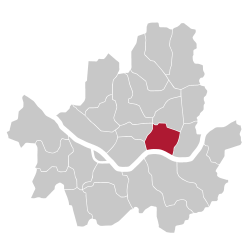
Wangsimni Station is a station on Seoul Subway Line 2, Seoul Subway Line 5, Gyeongui–Jungang Line, and Suin–Bundang Line; most Suin–Bundang Line trains end service here, though a few daily services continue along the tracks used by the Gyeonggi-Jungang line to terminate at the next station, Cheongnyangni in northeastern Seoul. It is located in Haengdang-dong, Seongdong-gu, Seoul.

Seongbuk District is one of the 25 districts of Seoul, South Korea. The district is located in the mid-north part of the city. The current mayor is Kim Young-bae (김영배), who has been mayor since July 1, 2010. Seongbuk-gu was established under Presidential Decree No. 159 on August 13, 1949, and was promoted to a autonomous district by implementing a Gu-level local government on May 1, 1988.

Gwangjin District is one of the 25 districts of Seoul, South Korea. It is located on the north bank of the Han River on the eastern end of Seoul. The district was split from the neighboring Seongdong District in 1995.
Cheonwang-dong is a dong, one part of Guro-gu in Seoul, South Korea. It is a legal dong administered under its administrative dong, Oryu 2-dong. Cheonwang-dong has large apartments for Seoul citizens called SHIFT which means low-cost, long period rent.

Sogong-dong is a dong of Jung-gu district in Seoul, South Korea.

Geumho-dong is a dong, neighborhood of Seongdong-gu in Seoul, South Korea.
Sinmunno 1-ga is a dong, neighbourhood of Jongno-gu in Seoul, South Korea. It is a legal dong administered under its administrative dong, Sajik-dong.

Sindang-dong (Korean: 신당동) is a dong, neighbourhood of Jung-gu in Seoul, South Korea.
Muhak-dong is a legal dong, or neighbourhood of the Jung-gu district in Seoul, South Korea and governed by its administrative dong, Sindang 1-dong.
Ssangnim-dong is a legal dong, or neighbourhood of the Jung-gu district in Seoul, South Korea, and governed by its administrative dong, Gwanghui-dong.
Oksu-dong is a dong, (neighbourhood), of Seongdong-gu in Seoul, South Korea.

Majang-dong (Korean: 마장동) is a dong, or neighbourhood of Seongdong-gu in Seoul, South Korea.
Haengdang-dong is a dong, neighbourhood of Seongdong-gu in Seoul, South Korea.

Seongsu-dong (Korean: 성수동) is a dong, or neighbourhood, of Seongdong District, Seoul, South Korea. It is further subdivided into Seongsu-dong 1-ga and Seongsu-dong 2-ga, and is served by Ttukseom Station and Seongsu Station on Seoul Subway Line 2 and by Seoul Forest Station on the Suin-Bundang Line. Its most notable attraction is Seoul Forest, a public park. The neighborhood has become popular in recent years for its array of cafes and restaurants, many of which have been set up in repurposed factories and old residential buildings, earning it the nickname "The Brooklyn of Seoul". There are also various stores built inside repurposed shipping containers.

Eungbong-dong is a dong, neighbourhood of Seongdong-gu in Seoul, South Korea.
Songjeong-dong is a dong (neighborhood) of Seongdong-gu in Seoul, South Korea.
Yongdap-dong is a dong, neighbourhood of Seongdong-gu in Seoul, South Korea.
Sangwangsimni-dong is a dong, neighbourhood of Seongdong-gu in Seoul, South Korea.
Hawangsimni-dong is a dong, neighbourhood of Seongdong-gu in Seoul, South Korea.
A dong (Korean: 동) or neighborhood is a submunicipal level administrative unit of a city and of those cities which are not divided into wards throughout Korea. The unit is often translated as neighborhood and has been used in both administrative divisions of North Korea and South Korea.














